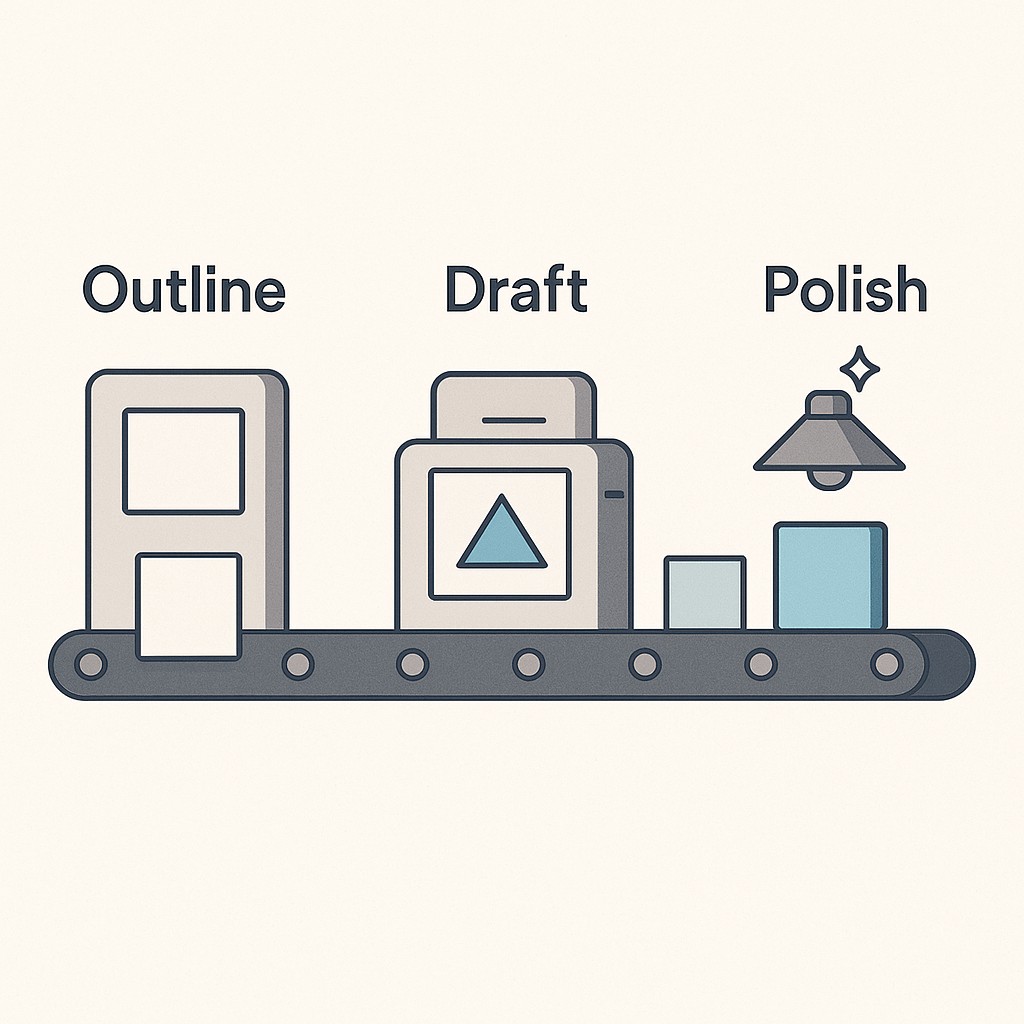Coordination Beats Verbosity: Design Modular LLM Workflows
Coordination Beats Verbosity: Design Modular LLM Workflows

The Prompt That Broke the Camel’s Back
I’ll be honest. I thought I was safe. My 2,000-token kitchen-sink prompt spelled out everything—formatting, context, even example citations. But it missed three critical formatting rules and hallucinated a source I never mentioned.
Early on, that sort of sprawling prompt worked just fine. For a few weeks, the results seemed strong enough. But once the system hit real volume, even my 2,000-token marvel started slipping, and every slip took longer to catch.
Six months ago, instead of trying to design modular LLM workflows, my approach was always “just write more.” When your agents start getting sloppy or skipping steps, it feels right to add more—more details, more guardrails, more context. You rewrite, you stuff every edge case in, hoping specificity means security. If you’re managing a team or working with non-technical folks, you really don’t want surprises. It feels safer to be exhaustive than to risk missing one thing.
Of course, my first reaction was to double down on detail. I read the output, saw a gap, patched the prompt, repeated. It’s like trying to fill a leaking boat by stuffing towels into every crack as they appear.
Here’s the uncomfortable truth. Coordination beats verbosity. Give the model a workflow that shows where to focus, not a script to memorize. The friction drops away. The leaner architecture doesn’t just save tokens, it actually raises reliability.
Why Prompt Bloat Breaks Reliability
Prompt bloat is sneaky. It creeps in when workflows expand—more context, more constraints, more examples—until you’re managing a sprawling wall of instructions. I’ve watched it happen every time a project grows. You’re just trying to make things clearer, but the prompt quickly turns into a catchall for every possible edge case.
The technical headache shows up fast. When everything feels important, the model’s attention gets scattered. I was asking it to remember a novel’s worth of rules, but the order and location of information actually matter more than we realize. When you let a prompt get too long, models start missing rules buried in the middle—changing position of information can dramatically shift model performance. And more context isn’t reliably better. Models typically plateau or dip when context length keeps increasing. You don’t need to bury the agent in reminders. Just make sure what you need stands out.
The hidden cost comes with state and memory. System prompts often persist across turns. That means you’re carrying baggage—some helpful, some confusing. Details you packed in for one output might trip up results two steps later. Over time, this carryover muddies instructions, pulling the agent further from your original intent. It’s the classic case of yesterday’s solution becoming today’s friction.
And then there’s pure token waste. I kept writing “must-haves,” then buried them under ten more. By the end, the model had to sift through a mountain of tokens just to find what mattered. With every extra example and “just in case” instruction, the cost per completion ticked up, and the reliability ticked down. Sometimes, I’d watch the output wander off-format, miss a key constraint, or hallucinate data—simply because the signal I cared about was drowned out by everything else. The agent wasn’t ignoring me. It was overloaded, plain and simple.
If you’re building agentic workflows at scale, prompt bloat isn’t just a nuisance—it’s a compounding cost. You spend more on every run, patch more mistakes, and rework outputs that should have just worked. Reliable coordination compounds. It lowers costs, reduces rework, and makes multi-step systems easier to maintain. Cutting through the bloat is not about being minimal. It’s about giving your agents a fighting chance to be consistent.
Lean Coordination: Small Systems, Big Consistency
This was the turning point. Bigger prompts didn’t fix anything. What worked was a smaller, sharper LLM workflow architecture.
Instead of scattering rules across a tangled prompt, I locked them down as centralized system rules in a single system block. It acts as a checklist for the model—always front and center, never lost in the weeds. You shouldn’t feel like you have to remind the agent about critical constraints on every run. By centralizing must-haves in one place, the mental overhead drops for everyone building or maintaining the workflow.
The next trick was breaking the workflow into single-purpose steps. I stopped jamming research, drafting, outlining, and polish cues into one prompt. I split them up: outline first, then pass the outline downstream to the drafting step, then polish at the end. Each step gets only what it needs.
Modular flows work best when each step passes only its final output downstream—never cluttering the next step with intermediate states or all inputs. This keeps everything clean. Your draft isn’t affected by how the outline was created, and polish doesn’t get tangled up in notes meant for earlier steps. It’s like an assembly line where every station has exactly one job, passing the finished part forward. You get fewer slipups, and the model’s focus stays sharp at every stage.

To tighten outputs even further, I began enforcing structured output schemas and types. Instead of asking for plain text, I’d say “return a JSON object with a ‘title: str’ field, and a ‘body: str’ field.” Or I’d pass in a Pydantic schema and require the output match it. Suddenly, ambiguity vanished. The agent knows exactly what goes where, and downstream steps don’t have to guess or fix formatting mistakes. You go from “I hope it follows the rules” to “the output either matches the schema or it doesn’t.” It’s a simple shift, but it kills hours of manual cleanup.
Reminds me of that late winter afternoon when I tried to fix my old coffee grinder. I thought more WD-40 and another round of fiddling would do it, but the handle kept catching at the same spot no matter what I tried. Eventually, I stopped adding fixes and just cleaned out the one stubborn gear. It was never about more effort—it was about finding the one spot that mattered. Anyway, the grinder works fine now, but I still reach for the oil every time it sticks, even though I should know better. This has started to echo in my systems work. Sometimes, I still add more detail before remembering less is more.
If I’m honest, this all started to feel familiar outside of AI workflows. My best woodworking projects didn’t come from buying more tools. They came from tighter jigs and cleaner cuts. It’s the coordination, not the complexity, that keeps things reliable every time.
Design Modular LLM Workflows That Actually Deliver
If you’re building out agentic systems, here’s the playbook to design modular LLM workflows—the dead-simple process that keeps every must-have intact, no matter how much your projects scale. Think of it as a practical path forward, not a theoretical detour.
First, get the rules out of the weeds and park them right in your system prompt. Give the model one unified checklist, visible on every run. Don’t scatter critical instructions across subtasks or examples. Keep your individual tasks lightweight—think single function, not multipurpose. All the constraints and non-negotiables? They live at the top, not buried three conversations deep. The system prompt becomes your contract. Everything else just executes.
Next, say goodbye to rambling instructions. Use punchy bullets for what you expect. “Output in exactly three sentences. Start every answer with ‘Summary.’ No outside citations.” Use schemas wherever you can. JSON is your friend. An explicit structure (“field, type, required”) is miles clearer than clever prose. When you show the model exactly what the output should look like—down to format and length—you cut out most guesswork. And the results stay clean as things get more complex. Your future self (and your teammates) will thank you.
Once you’ve got those building blocks, move fast but test small. Feed in bite-sized examples and log what breaks. Look for the misses. Did it drop a rule, fudge a format, hallucinate something strange? Do this daily. Just block 15 minutes. Small, relentless tweaks build muscle. Waiting weeks to review means problems compound. The best AI-build insights come when you iterate daily, not when you whiteboard a grand design upfront.
That’s it. The three-step process that’s kept my workflows lean and rock-solid, even as needs changed. Centralize the rules. Enforce format with bullets and schemas. Test in short cycles. Coordination, not verbosity, is how your agents finally start to deliver what you asked for.
Put lean coordination into practice; use the app to generate AI-powered content with schemas, structured outputs, and focused steps, so you get clean, on-format drafts faster without kitchen-sink prompts.
Your Move: Shrink Prompt Bloat Without Losing Specificity
I get the worry. If you try to reduce LLM prompt bloat, it’s easy to wonder if you’ll lose all the little cues that actually keep outputs on track—or end up with a system so rigid you can’t tweak anything. I felt it every time a teammate asked, “But what if the agent misses the nuance?” Cutting back isn’t about dumbing down. It’s about focusing on what actually drives results. You’re not sacrificing specificity, you’re trading verbose reminders for intentional coordination.
That’s where modular AI workflow design comes in. Instead of cramming every rule and exception into a mega-prompt, breaking things down actually sharpens what the model pays attention to and slashes error rates. Less text, more clarity. In practice, those small, focused workflows deliver sharper, more predictable outputs than giant context dumps ever did.
The upside here isn’t just a tidier workflow. It’s compounding reliability. When you bake the rules into your architecture, the model learns where to focus, not just what to memorize. Coordination beats verbosity. By making critical constraints visible and structuring the steps, you stop playing token whack-a-mole every time something changes. Not only do you lower costs (fewer wasted tokens), you also cut rework and make multi-agent setups way easier to maintain as things grow. If you’re hoping to scale up and not drown in corrective edits, this approach gives you leverage.
If you’re stuck with a kitchen-sink prompt right now, pick one chunk to trim and move a rule to your system block today. That small shift is how you start turning prompt chaos into consistency—and leave behind the pain that sparked all this in the first place.
There’s probably a corner case where more detail really does help and I haven’t figured out how to spot it up front. I still go too heavy sometimes before I remember the grinder. But the playbook works well enough that I trust the process now more than my gut.
Enjoyed this post? For more insights on engineering leadership, mindful productivity, and navigating the modern workday, follow me on LinkedIn to stay inspired and join the conversation.
